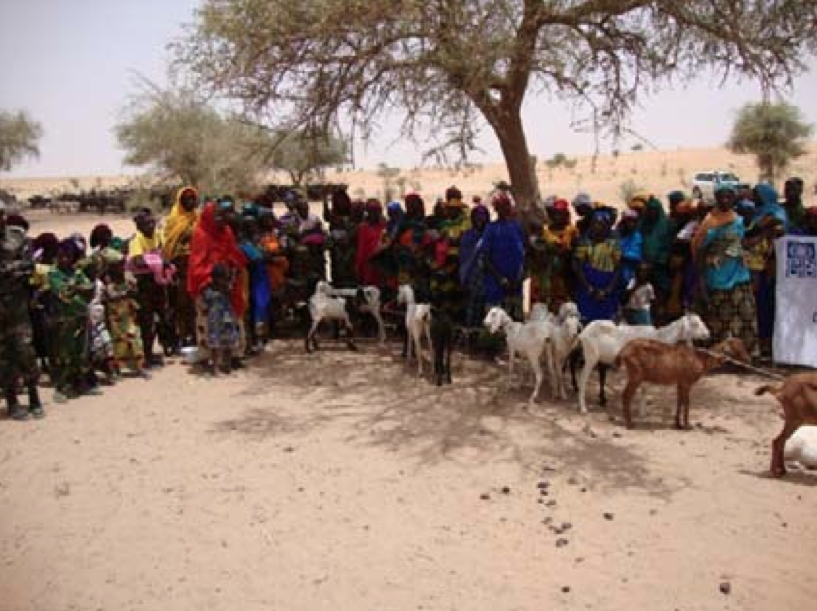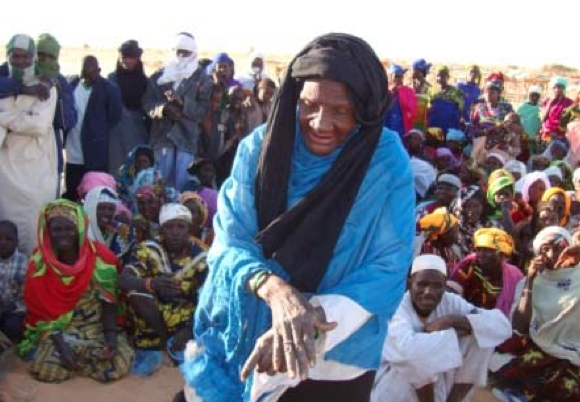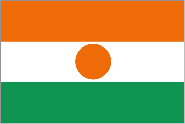CBA Niger: Intensified Goat Breeding to Help Vulnerable Women Adapt to Climate Change Effects (N'Niyat)
Project Overview
This Community-Based Adaptation project focused on 14 villages in Tamalolo, a Sahelo-Saharan zone of Niger.
The region is characterized by precipitation shortages, violent winds, droughts, extreme temperatures, dust storms, grasshopper infestations, and bush fires. As these climatic phenomena intensify, they will damage local ecosystems and livelihoods. A projected increase in soil erosion will augment the vulnerability of natural and agropastoral ecosystems. Over the long-term, the production risks and the survival of communities dependent on these natural resources will be seriously endangered.
Women make up 51 percent of the Tamalolo population. The ancient tradition of goat breeding, upon which women rely as an important source of income, is now hindered by climate change effects. To address this population’s extreme vulnerability, the project focused on reducing degradation and protecting the affected ecosystem to improve living conditions in the site area. The sustainable practices developed for women will simultaneously increase family incomes and improve Tamalolo’s ecology and biodiversity.
* This project was part of Niger's Community-Based Adaptation portfolio. *
Project Details
This Community-Based Adaptation project focuses on the women of the 14 villages of Tamalolo, an area in the Zinder Region of Niger. Women make up 51 percent of the population there (2,216 residents), and are extremely vulnerable to the impacts of climate change.
Goat breeding, an ancient tradition and an important source of income for local women, has ben hit hard by climate change effects. Changes in weather patterns have led to deficient cereal and fodder production, and recurring floods have decimated the zone’s livestock. Additionally, an increase in violent winds that cause sand dunes and glacis to invade farm lands has led to land degradation, wind and water erosion.
As a result, the communities’ farming, pastoral and agricultural production has become uncertain, and poverty levels, particularly amongst women and children, are on the rise. The reduction in goat breeding caused by climate change is forcing women to pursue income-generating activities such as small trade (sale of doughnuts, condiments, boule, straw, firewood, etc.). This shift in activities is contributing to land degradation and preventing communities from reaching previous levels of goat breeding.
To address the population’s extreme vulnerability, this project focuses on reducing degradation and protecting the affected ecosystem to improve living conditions in the site area. Sustainable practices developed for women, such as goat herding, should simultaneously increase family incomes and improve Tamalolo’s ecology and biodiversity.
The Tanout-based NGO N’NIYAT, together with the target community, is implementing this project. This NGO is familiar with the Tamalolo area and is aware of the problems being experienced by the populations in this zone. Specifically, the project will take on awareness raising campaigns and trainings (particularly for women) on the effects of climate change and on fodder (stray and farming by-products) conservation techniques. It will identify the most vulnerable women in the area who would most benefit from goat breeding (280 women total) and assist with the process of acquiring and managing goatherds and livestock food inventory. Three livestock feed stores will be constructed, including one per zone, and an initial stock of livestock will be purchased. Finally, women will be trained women to recognize and diagnose the most common goat illnesses and identify their symptoms, and to understand the importance of vaccination and treating the animals.
Together, these activities will make the Tamalolo zone more resilient to projected climate change impacts, thereby decreasing the vulnerability of the ecosystem and improving the community’s food security and livelihood conditions.This Community-Based Adaptation project focuses on the women of the 14 villages of Tamalolo, an area in the Zinder Region of Niger. Women make up 51 percent of the population there (2,216 residents), and are extremely vulnerable to the impacts of climate change.
Goat breeding, an ancient tradition and an important source of income for local women, has ben hit hard by climate change effects. Changes in weather patterns have led to deficient cereal and fodder production, and recurring floods have decimated the zone’s livestock. Additionally, an increase in violent winds that cause sand dunes and glacis to invade farm lands has led to land degradation, wind and water erosion.
As a result, the communities’ farming, pastoral and agricultural production has become uncertain, and poverty levels, particularly amongst women and children, are on the rise. The reduction in goat breeding caused by climate change is forcing women to pursue income-generating activities such as small trade (sale of doughnuts, condiments, boule, straw, firewood, etc.). This shift in activities is contributing to land degradation and preventing communities from reaching previous levels of goat breeding.
To address the population’s extreme vulnerability, this project focuses on reducing degradation and protecting the affected ecosystem to improve living conditions in the site area. Sustainable practices developed for women, such as goat herding, should simultaneously increase family incomes and improve Tamalolo’s ecology and biodiversity.
The Tanout-based NGO N’NIYAT, together with the target community, is implementing this project. This NGO is familiar with the Tamalolo area and is aware of the problems being experienced by the populations in this zone. Specifically, the project will take on awareness raising campaigns and trainings (particularly for women) on the effects of climate change and on fodder (stray and farming by-products) conservation techniques. It will identify the most vulnerable women in the area who would most benefit from goat breeding (280 women total) and assist with the process of acquiring and managing goatherds and livestock food inventory. Three livestock feed stores will be constructed, including one per zone, and an initial stock of livestock will be purchased. Finally, women will be trained women to recognize and diagnose the most common goat illnesses and identify their symptoms, and to understand the importance of vaccination and treating the animals.
Together, these activities will make the Tamalolo zone more resilient to projected climate change impacts, thereby decreasing the vulnerability of the ecosystem and improving the community’s food security and livelihood conditions.
Key Results and Outputs
- Conduct awareness-raising campaigns and trainings (particularly for women) on the effects of climate change and on fodder (stray and farming by-products) conservation techniques.
- Identify the most vulnerable women in the area who would most benefit from goat breeding (on average 20 women per village, corresponding to a total of 280 women for the 14 villages organized into 3 groups, that is 1 group per subzone).
- Assist with the process of acquiring and managing goatherds and livestock food inventory. Construct three livestock feed stores, including one per zone, and purchases/implements an initial stock of livestock feed comprised of 17 tons of wheat bran and 17 tons of cottonseed.
- Purchase and distribute caprines, including goats (two per woman) and billy goats (one billy goat per village).
- Train women to recognize and diagnose the most common goat illnesses and identify their symptoms, and to understand the importance of vaccination and treating the animals.
Reports and Publications
Brochures, Posters, Communications Products
Annual Reports
Project Brief / Fact Sheet
Monitoring and Evaluation
Monitoring and evaluation for community-based adaptation is a new field, and the CBA project is piloting innovative approaches to evaluating the success of locally-driven adaptation projects, and generating lessons to inform ongoing practice.
Key considerations in M&E for CBA include:
- Grounding M&E in the local context: M&E for CBA should avoid overly rigid frameworks, recognizing community heterogeneity and maintaining local relevance
- Capturing global lessons from local projects: CBA projects are highly contextualized, but lessons generated should be relevant to stakeholders globally
- Incorporation of both quantitative and qualitative indicators: to ground projects in tangible changes that can be objectively evaluated, and to capture lessons and case studies for global dissemination
To these ends, the CBA project uses three indicator systems: the Vulnerability Reduction Assessment, the Small Grants Programme Impact Assessment System, and the UNDP Climate Change Adaptation Indicator Framework.
The Vulnerability Reduction Assessment (VRA)
The VRA is a question-based approach with the following aims:
- To make M&E responsive to community priorities
- To use M&E to make projects more accountable to local priorities
- To make M&E capture community ideas and local knowledge
- To gather community-level feedback to guide ongoing project management
- To generate qualitative information
- To capture lessons on specific issues within community-based adaptation
- To generate case studies highlighting adaptation projects
The VRA follows UNDP's Adaptation Policy Framework, and is measured in a series of meetings with local community stakeholders. In these meetings, locally-tailored questions based on standard VRA questions/indicators are posed, and the community assigns a numerical score on a 1-10 scale for each question. Progress is evaluated through changes in scores over the course of implementation, as well as through qualitative data collected in community discussions surrounding the exercise.
UNDP has developed a Users Guide to the VRA (Espanol) (Francais) as a tool to assist practitioners to conceptualize and execute VRA measurements in the context of CBA projects.
The SGP Impact Assessment System (IAS)
The CBA, being a project of the GEF Strategic Priority on Adaptation, aims to increase the resilience of ecosystems and communities to the impacts of climate change, generating global environmental benefits, and increasing their resilience in the face of climate change impacts. To this end, the CBA projects use the SGP's impact assessment system for monitoring achievements in GEF focal areas (focusing primarily on biodiversity and sustainable land management).
The IAS is composed of a number of quantitative indicators which track biophysical ecosystem indicators, as well as policy impact, capacity development and awareness-building.
UNDP Climate Change Adaptation Indicator Framework
CBA projects also track quantitative indicators from UNDP's adaptation indicator framework, corresponding to the thematic area on natural resources management. More information on UNDP's indicator framework can be found on the UNDP climate change adaptation monitoring and evaluation website.
* This description applies to all projects implemented through UNDP's Community-Based Adaptation programme. Specific details on this project's M&E will be included here as they become available. *






